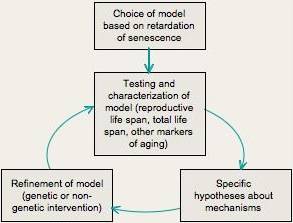Gerontology: mechanisms of aging
We die from the first thing that kills us. As we age, we become progressively more susceptible to disease, so if we don't die from one disease, we die from the next most competitive disease — or the next. For example, as humans, if we don't die from cancer, we might die from heart disease, stroke, or kidney failure, each of which could have been progressing simultaneously with the others, but at its own rate. The disease we die from is the one that progresses to a level of seriousness that causes the failure of a vital biological system. To maintain health and extend our lives, we must delay or prevent all the diseases of old age.
 It is this philosophy that leads us to search for mouse models of delayed senescence and to study the mechanisms by which senescence is delayed in those models. We have no pre-conceived notions: We start with a model that works and investigate why it does. As we learn about the mechanisms, we develop hypotheses. The more we learn, the more refined our hypotheses become. Our long-term goal is to develop interventions, suitable for human beings, that delay aging and prolong health.
It is this philosophy that leads us to search for mouse models of delayed senescence and to study the mechanisms by which senescence is delayed in those models. We have no pre-conceived notions: We start with a model that works and investigate why it does. As we learn about the mechanisms, we develop hypotheses. The more we learn, the more refined our hypotheses become. Our long-term goal is to develop interventions, suitable for human beings, that delay aging and prolong health.
Here we offer brief overviews of our current gerontology programs, along with some information about how we use life span as a biomarker to quantify aging. We also provide some interesting data related to aging and life span that we've collected over the years but have not published.